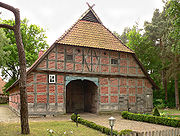
Winsen Museum Farm
Encyclopedia

Winsen (Aller)
Winsen an der Aller or Winsen is a town in the district of Celle in the German state of Lower Saxony.-Geography:Winsen has around 12,900 inhabitants and lies on the southern perimeter of the Lüneburg Heath, on the banks of the Aller, somewhat to the west of its tributary, the Örtze and about...
in the north German state of Lower Saxony
Lower Saxony
Lower Saxony is a German state situated in north-western Germany and is second in area and fourth in population among the sixteen states of Germany...
. It was started in 1982 and comprises a typical farmyard from the southern Lüneburg Heath
Lüneburg Heath
The Lüneburg Heath is a large area of heath, geest and woodland in northeastern part of the state of Lower Saxony in northern Germany. It forms part of the hinterland for the cities of Hamburg, Hanover, and Bremen and is named after the town of Lüneburg. Most of the area is a nature reserve...
around which other buildings, characteristic of the region, are grouped.
Museum site
The museum is situated in the residential part of Winsen within an extensive, tree-covered area with a low hill and the typical appearance of heath country.The museum is sponsored by the Winsen Local Heritage Society (Winsener Heimatverein) which was founded in 1979 by 10 people. Currently (2009) the society has about 800 members. The members have largely carried out the building work on the museum site themselves.
Buildings
All the buildings in the open-air museum were translocated to this site. They were originally built between the mid-17th century and the 20th century. Their interiors and the implements exhibited stem mainly from the 19th century.Farmyards
The centrepiece of the museum is a rural farmstead from the Südheide ("South Heath"), which has 6 historical buildings. The main building is a Lower Saxon house, the so-called Fachhallenhaus, a timber-framed, hall house divided into bays, built in Winsen in 1653. In 1980 it was transferred from its former site and in 1982 rebuilt on its new location as the open-air museum's first building.Amongst the outbuildings are a barn dating back to 1727 and an 1840 hay barn from Hornbostel made of wood previously used in other buildings. The pig shed from 1860 was part of a farmyard in Südwinsen until 1985. A storage barn with outside staircase (Treppenspeicher
Treppenspeicher
A Treppenspeicher is the German term for a small barn or secondary farm building used for storage and typical of the Lüneburg Heath area in northern Germany...
) from the first half of the 18th century houses exhibitions with beekeeping
Beekeeping
Beekeeping is the maintenance of honey bee colonies, commonly in hives, by humans. A beekeeper keeps bees in order to collect honey and other products of the hive , to pollinate crops, or to produce bees for sale to other beekeepers...
equipment and items of laundry made of linen
Linen
Linen is a textile made from the fibers of the flax plant, Linum usitatissimum. Linen is labor-intensive to manufacture, but when it is made into garments, it is valued for its exceptional coolness and freshness in hot weather....
. The barn was moved to Winsen in 1981 from its original site on the Bergen-Hohne Training Area
Bergen-Hohne Training Area
Bergen-Hohne Training Area is a NATO military training area in the southern part of the Lüneburg Heath, in the state of Lower Saxony in northern Germany. It covers an area of , which makes it the largest military training area in Germany.It was established by the German armed forces, the...
. The bakehouse was reconstructed from old prototypes and is occasionally used to bake bread.
Other buildings
Other historical buildings from the region have been rebuilt on the museum site, bordering the farmyard. The main one is Dat groode Hus, a farmhouse that dates back to 1795 in Buchholz (Aller) and was transported here in 1991. As the largest building in the museum it is used for cultural events such as concerts, recital and presentations. It has a Trauzimmer for the community. In 2005 the Kalandhof farm, that had existed in Winsen since 1781, was rebuilt here. Its name is based on the duty owed by the builder to the Kaland brotherhood. The museum cafe is located here. The other buildings are an 1860 coach house and two other TreppenspeicherTreppenspeicher
A Treppenspeicher is the German term for a small barn or secondary farm building used for storage and typical of the Lüneburg Heath area in northern Germany...
barns. An apiary
Apiary
An apiary is a place where beehives of honey bees are kept. Traditionally beekeepers paid land rent in honey for the use of small parcels. Some farmers will provide free apiary sites, because they need pollination, and farmers who need many hives often pay for them to be moved to the crops when...
provides an insight into heath beekeeping which was formerly widespread in this area. Finally, there is also a fruit orchard with apple trees common to the region.

